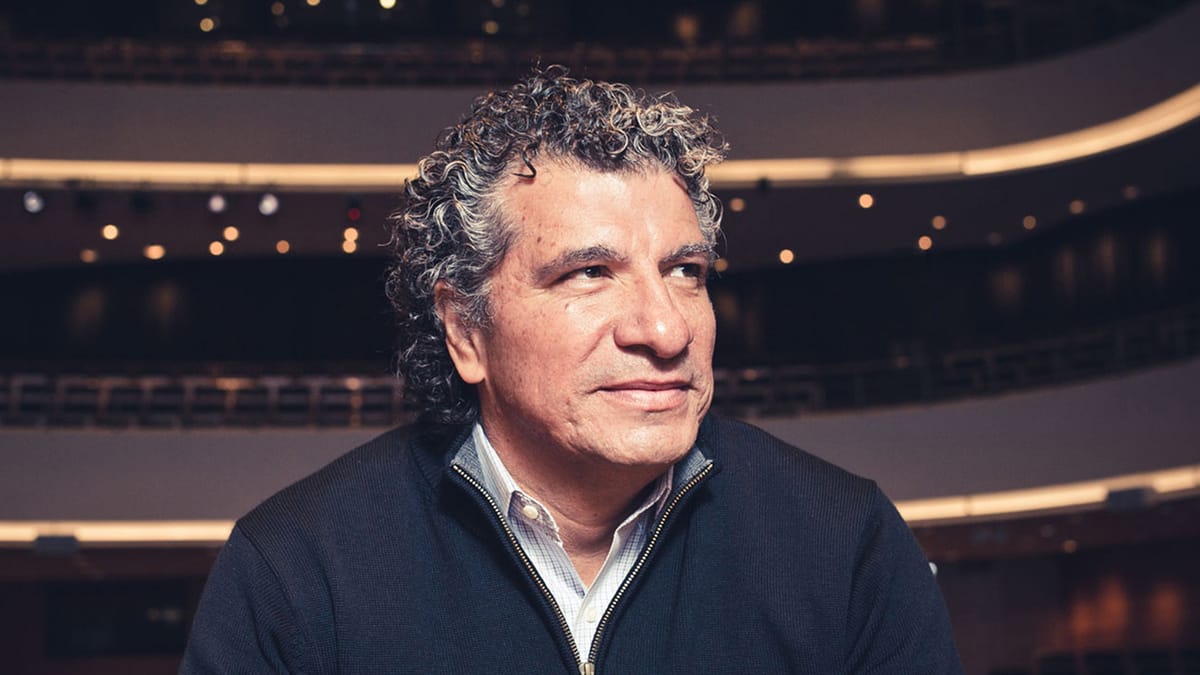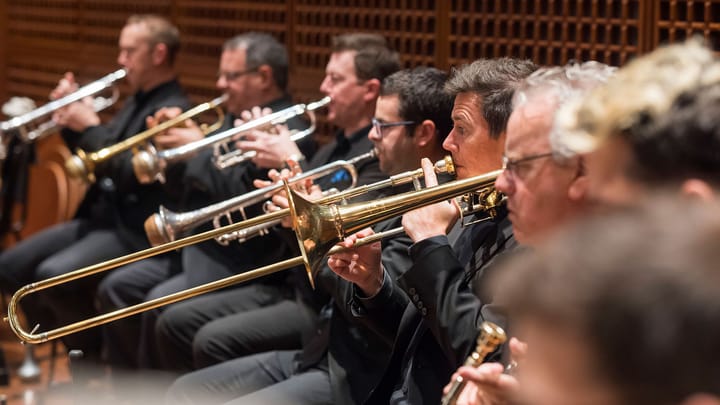In This Program
The Concert
Friday, May 2, 2025, at 7:30pm
Saturday, May 3, 2025, at 7:30pm
Giancarlo Guerrero conducting
Kaija Saariaho
Asteroid 4179: Toutatis (2005)
First San Francisco Symphony Performances
Igor Stravinsky
Petrushka (1911, rev. 1947)
The Shrove-tide Fair
Petrushka’s Room
The Moor’s Room
The Grand Carnival
Intermission
Ottorino Respighi
Fountains of Rome (1916)
The Fountain of Valle Giulia at Dawn
The Triton Fountain in the Morning
The Fountain of Trevi at Mid-day
The Villa Medici Fountain at Sunset
Pines of Rome (1924)
The Pines of the Villa Borghese
Pines Near a Catacomb
The Pines of the Janiculum
The Pines of the Appian Way
Giancarlo Guerrero’s appearance is supported by the Louise M. Davies Guest Conductor Fund.
Program Notes
At a Glance
On the second half are Ottorino Respighi’s Fountains of Rome and Pines of Rome—two vivid Italian postcards that come from roughly the same era but represent a very different style than that of Stravinsky’s ballet. While generally embracing a conservative aesthetic, Pines was also innovative in its early use of electric recording to portray a nightingale’s song.
Asteroid 4179: Toutatis
Kaija Saariaho
Born: October 14, 1952, in Helsinki
Died: June 2, 2023, in Paris
Work Composed: 2005
First SF Symphony Performances
Instrumentation: 2 flutes, piccolo, 3 oboes, 3 clarinets, bassoon, contrabassoon, 6 horns, 4 trumpets, 3 trombones, tuba, timpani, percussion (bowed crotales, suspended cymbal, tam-tam, bass drum, glockenspiel, vibraphone, and marimba), 2 harps, celesta, and strings
Duration: About 4 minutes

Not quite two years have passed since the death of Kaija Saariaho. Her legacy continues to enrich the Bay Area’s cultural life in particular. The San Francisco Symphony and Chorus’s live concert recording of her opera Adriana Mater—led by Esa-Pekka Salonen in June 2023, just days after the composer’s passing—garnered the 2025 Grammy Award for Best Opera Recording, while a highlight of San Francisco Opera’s previous season was the American premiere of her final opera, Innocence—an unflinchingly complex portrayal of the impact of a school shooting.
Saariaho navigated her way through the male-dominated cultural landscape of the composition world, becoming the only woman in her class at the Sibelius Academy. She resettled in the early 1980s in Paris, where she found an artistic home at IRCAM, the center for musical research and technology established by Pierre Boulez. One strand among Saariaho’s wide array of influences was her flexible approach to techniques and tools developed by the “spectralist” composers at IRCAM who used computers to analyze the complex spectra produced by sounds, at times incorporating live electronics to expand their soundscapes.
Saariaho developed a distinctive aesthetic marked by a mindful attention to sound colors and a sustained focus on processes of transformation and their perception. A compact but highly memorable example is presented by Asteroid 4179: Toutatis, which dates from 2005—around the same period when Saariaho was composing Adriana Mater and her oratorio La Passion de Simone (which local music lovers might recall from its Cal Performances staging in 2016). Asteroid 4179: Toutatis was commissioned by the Berlin Philharmonic as a companion piece for a program featuring Gustav Holst’s The Planets, and was premiered on March 16, 2006, with Simon Rattle conducting.
The title comes from the International Astronomical Union’s official designation for an elongated asteroid named after a totemic Celtic god who served as a tribal protector in ancient Gaul. First catalogued in 1934, Toutatis received its current name when this Earth-crossing asteroid was rediscovered in 1989, capturing intentional headlines—not unlike asteroid 2024 YR4, which has created a stir since its discovery in late December as scientists continue to recalibrate the potential of a future collision. NASA’s Jet Propulsion Laboratory has described 4179 Toutatis as “one of the strangest objects in the solar system, with a highly irregular shape and an extraordinarily complex ‘tumbling’ rotation.”
In lieu of a fixed north pole such as we know on Earth, its north pole wanders along a curve about every 5.4 days, according to the NASA study. To a viewer on Toutatis, stars would not repeatedly follow circular paths, but would crisscross the sky, never following the same path twice. Toutatis’s orientation in the solar system never repeats.
The Music
Frequently inspired by visual impressions and the qualities of light, Saariaho was intrigued by images of Toutatis, especially “its unusual shape,” as well as its chaotic orbit and the fact that “different areas . . . rotate at different speeds.” She occasionally creates the illusion of electronics despite deploying a purely acoustic orchestra. Along with mystery, violently dramatic eruptions suggest the asteroid’s history of multiple collisions with other objects in space. Like one of Alexander Calder’s mobiles, sonorities hover and shift with uncanny presence, evoking aural mirages that seem to shimmer, dissolve, and coalesce anew, blurring the lines between the ephemeral and the ethereal.
—Thomas May
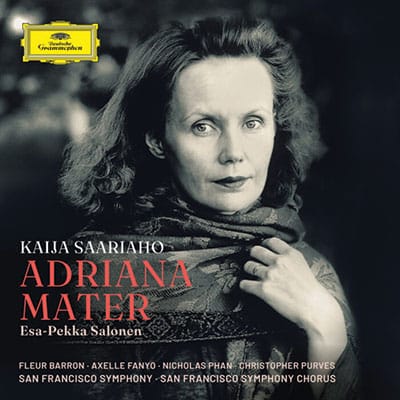
Find Esa-Pekka Salonen, the San Francisco Symphony, and SF Symphony Chorus’s Grammy Award–winning recording of Saariaho’s opera Adriana Mater (Deutsche Grammophon 2024) on all major streaming services.
Petrushka
Igor Stravinsky
Born: June 17, 1882, in Oranienbaum, Russia
Died: April 6, 1971, in New York
Work Composed: 1910–11 (rev. 1947)
SF Symphony Performances: First—July 1929. Eugene Goossens conducted. Most recent—September 2018. Michael Tilson Thomas conducted.
Instrumentation: 3 flutes (3rd doubling piccolo), 2 oboes, English horn, 3 clarinets (3rd doubling bass clarinet), 2 bassoons, contrabassoon, 4 horns, 3 trumpets, 3 trombones, tuba, timpani, percussion (triangle, cymbals, suspended cymbals, tam-tam, tambourine, snare drum, bass drum, and xylophone), harp, celesta, piano, and strings
Duration: About 35 minutes
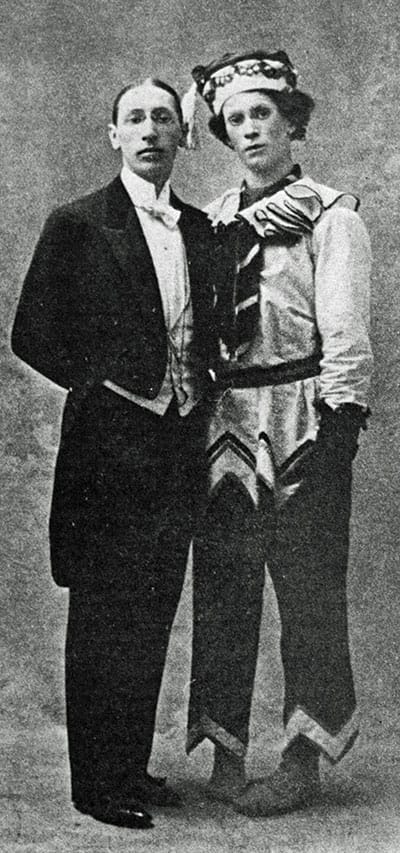
Here is young man’s music, though Igor Stravinsky at 28 was a fully developed artistic personality, dazzlingly and completely himself. The Firebird had been an immense success when Sergei Diaghilev produced it at the Paris Opera on June 25, 1910. Stravinsky had already begun to contemplate The Rite of Spring, but found that what he really wanted after Firebird was the change and refreshment of writing a sort of concert piece for piano and orchestra: “I had in mind a distinct picture of a puppet, suddenly endowed with life, exasperating the patience of the orchestra with diabolical cascades of arpeggi. The orchestra in turn retaliates with menacing trumpet blasts. The outcome is a terrific noise which reaches its climax and ends in the sorrowful and querulous collapse of the poor puppet.”
Once again, Diaghilev was quick to perceive the possibilities. The two sketched the outlines of a ballet, agreed on a commission fee of 1,000 rubles, and decided that the scenario should be worked out by Alexandre Benois, the painter who had been one of Diaghilev’s original advisers at the founding of the Ballets Russes and had loved puppet theater since boyhood. On May 26, 1911, in Stravinsky’s room at the Albergo d’Italia, in Rome, the last bars were written. Just 18 days later, Petrushka went on stage with Vaslav Nijinsky as the title character, and it was another triumph, though the Paris orchestra required a little persuading.
The Story and Music
The curtain rises to show Admiralty Square, Saint Petersburg, in the 1830s. It is a sunny winter’s day, and the Shrove-tide Fair is in progress. Crowds move about. Not everyone is quite sober. Two rival street dancers entertain, one with an organ grinder and the other with a music box. Drummers draw the crowd’s attention to an old Magician, who descends from his theater, plays the flute, and presents his three puppets—Petrushka, the Ballerina, and the Moor. Touching them with his flute, he brings them to life. To the amazement of all, they too step down from the theater and perform a Russian dance in the midst of the crowd.
The second scene is set in Petrushka’s room. Its walls are black, decorated with stars and a crescent moon. The door leading to the Ballerina’s room has devils painted on it. A scowling portrait of the Magician dominates the space. When the curtain rises, the door of the cell is opened and a large foot kicks Petrushka inside. The preface to the score tells us:
While the Magician’s magic has imbued all three puppets with human feelings and emotions, it is Petrushka who feels and suffers most. Bitterly conscious of his ugliness and grotesque appearance, he feels himself to be an outsider, and he resents the way he is completely dependent on his cruel master. He tries to console himself by falling in love with the Ballerina. She visits him, and for a moment he believes he has succeeded in winning her. But she is frightened by his uncouth antics and she flees. In his despair, Petrushka curses the Magician and hurls himself at his portrait, but succeeds only in tearing a hole in the cardboard wall of his cell.
Scene three takes us to the Moor’s room, papered with a pattern of green palm trees and fantastic fruits against a red ground. The Moor is brutal and stupid, but attractive to the ballerina. She comes to visit him and succeeds in distracting him from the coconut with which he is playing. Their scene together is interrupted by the jealously enraged Petrushka, whom, however, the Moor quickly throws out.
The last scene takes us back to the fairgrounds, but it is now evening. Various groups dance until shouts are heard from the little theater. The sense of something wrong spreads to the dancers, who gradually stop their swirling. Petrushka runs from the theater, pursued by the Moor, whom the Ballerina is trying to restrain. The Moor catches up with Petrushka and strikes him with his saber. Petrushka falls, his skull broken. As he dies, a policeman goes to fetch the Magician. He arrives, picks up the corpse, shakes it. The crowd disperses. The Magician drags Petrushka toward the theater, but above the little structure, Petrushka’s ghost appears, threatening the Magician and thumbing his nose at him. Terrified, the Magician drops the puppet and hurries away.
—Michael Steinberg
Fountains of Rome
Pines of Rome
Ottorino Respighi
Born: July 9, 1879, in Bologna, Italy
Died: April 18, 1936, in Rome
Work Composed: Fountains—1914–16. Pines—1923–24.
SF Symphony Performances: First performance of Fountains—June 1926. Nikolai Sokoloff conducted. Most recent—October 2012. Vasily Petrenko conducted. First performance of Pines—October 1926. Alfred Hertz conducted. Most recent—June 2022. Esa-Pekka Salonen conducted.
Instrumentation: Fountains—2 flutes, piccolo, 2 oboes, English horn, 2 clarinets, bass clarinet, 2 bassoons, 4 horns, 3 trumpets, 3 trombones, tuba, timpani, percussion (triangle, cymbals, suspended cymbals, bells, and chimes), 2 harps, piano, celesta, organ, and strings.
Pines—3 flutes (3rd doubling piccolo), 2 oboes, English horn, 2 clarinets, bass clarinet, 2 bassoons, contrabassoon, 4 horns, 3 trumpets, 3 trombones, tuba, timpani, percussion (triangle, cymbals, tam-tam, bells, tambourine, ratchet, and bass drum), harp, celesta, piano, organ, and strings, plus recorded birdsong (nightingale), 6 offstage buccine (ancient Roman military instruments, here replaced by 2 trumpets and 4 trombones)
Duration: Fountains—about 16 minutes. Pines—about 23 minutes.
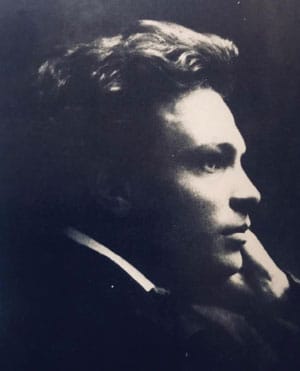
Though he was schooled in his native Bologna, Ottorino Respighi started his career in earnest as an orchestral viola player in Russia, where he had the opportunity to study with Nicolai Rimsky-Korsakov. Further work ensued in Berlin, with Max Bruch, before Respighi returned to Italy, where he would make his mark.
Though Respighi was briefly swept up in a burst of modernist enthusiasm, he soon retreated to his essentially conservative stance. By 1932 we find him joining nine other conservative composers to sign a manifesto condemning the deleterious effect of music by such figures as Schoenberg and Stravinsky and encouraging a return to established Italian tradition. Respighi was by then very famous and very rich. Success had come his way through his hugely popular tone poem Fountains of Rome. He followed up with two further, vaguely related, tone poems—Pines of Rome (1923–24) and Roman Festivals (1928). One of the traits that set Respighi apart as an individual voice was his fascination with the music of Italy’s distant past. Another distinctive Respighian hallmark: his willingness to go what many would consider over the top in terms of orchestral sonority and color.
Respighi himself left extensive prose descriptions of his “Roman Triptych.” About Fountains of Rome he wrote:
In this symphonic poem the composer has endeavored to give expression to the sentiments and visions suggested to him by four of Rome’s fountains, contemplated at the hour when their characters are most in harmony with the surrounding landscape, or at which their beauty is most impressive to the observer.
The first part of the poem, inspired by the fountain of Valle Giulia, depicts a pastoral landscape: droves of cattle pass and disappear in the fresh, damp mists of the Roman dawn.
A sudden loud and insistent blast of horns above the trills of the whole orchestra introduces the second part, “The Triton Fountain.” It is like a joyous call, summoning troops of naiads and tritons, who come running up, pursuing each other and mingling in a frenzied dance between the jets of water.
Next there appears a solemn theme borne on the undulations of the orchestra. It is the fountain of Trevi at mid-day. The solemn theme, passing from the woodwind to the brass instruments, assumes a triumphal character. Trumpets peal: Across the radiant surface of the water there passes Neptune’s chariot drawn by seahorses and followed by a train of sirens and tritons. The procession vanishes while faint trumpet blasts resound in the distance.
The fourth part, the Fountain at the Villa Medici, is announced by a sad theme which rises above the subdued warbling. It is the nostalgic hour of sunset. The air is full of the sound of tolling bells, the twittering of birds, the rustling of leaves. Then all dies peacefully into the silence of the night.
About Pines of Rome, Respighi commented:
The Pines of the Villa Borghese (Allegretto vivace)—Children are at play in the pine groves of the Villa Borghese, dancing the Italian equivalent of “Ring around a Rosy.” They mimic marching soldiers and battles. They twitter and shriek like swallows at evening, coming and going in swarms. Suddenly the scene changes.
The Pines Near a Catacomb (Lento)—We see the shadows of the pines, which overhang the entrance of a catacomb. From the depths rises a chant, which echoes solemnly, like a hymn, and is then mysteriously silenced.
The Pines of the Janiculum (Lento)—There is a thrill in the air. The full moon reveals the profile of the pines of Gianicolo’s Hill. A nightingale sings.
The Pines of the Appian Way (Tempo di Marcia)—Misty dawn on the Appian Way. The tragic country is guarded by solitary pines. Indistinctly, incessantly, the rhythm of unending steps. The poet has a fantastic vision of past glories. Trumpets blare, and the army of the Consul bursts forth in the grandeur of a newly risen sun toward the Sacred Way, mounting in triumph the Capitoline Hill.
Pines of Rome is famous for being one of the first pieces to include electronics in its orchestration. However subversive it seems in retrospect, this arrived in the most innocent fashion: through the composer’s instruction to play a recording of a nightingale at the end of the third movement. In the published score, Respighi suggested that the commercial recording issued by the Concert Record Gramophone Company as R6105 be used.
—James M. Keller
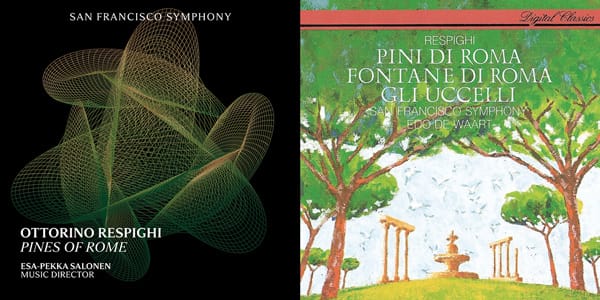
LISTEN AGAIN
Hear Esa-Pekka Salonen and the San Francisco Symphony’s recording of Pines of Rome (SFS Media, 2023) on Apple Music Classical and other major streaming services.
A classic 1983 recording, conducted by Edo de Waart (Philips), is also available, along with Respighi’s Fountains of Rome and The Birds.
About the Artist
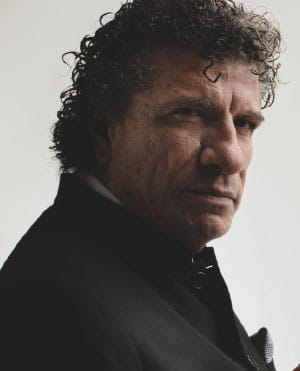
Giancarlo Guerrero
Giancarlo Guerrero is a six-time Grammy Award–winning conductor now in his 16th and final season as music director of the Nashville Symphony. During his tenure there, he commissioned and premiered nearly two dozen pieces and released 21 commercial recordings, garnering 13 Grammy nominations and six Grammy Awards. Guerrero serves as music director designate of Sarasota Orchestra in 2024–25 and becomes music director in the 2025–26 season.
Guerrero has been a frequent guest conductor in North America, performing with the New York Philharmonic, Los Angeles Philharmonic, Chicago Symphony, Boston Symphony, Philadelphia Orchestra, Dallas Symphony, National Symphony Orchestra, Baltimore Symphony, Detroit Symphony, Seattle Symphony, and Houston Symphony. He made his San Francisco Symphony debut in February 2013.
With the NFM Wrocław Philharmonic, where he served as music director for six seasons, Guerrero recorded the Billboard chart-topping album Bomsori: Violin on Stage for Deutsche Grammophon. He has also held posts as principal guest conductor of the Cleveland Orchestra, music director of the Eugene Symphony, and associate conductor of the Minnesota Orchestra.
Born in Nicaragua, Guerrero immigrated during his childhood to Costa Rica, where he joined the local youth symphony. He studied percussion and conducting at Baylor University and earned his master’s degree in conducting at Northwestern. Guerrero is particularly engaged with conducting training orchestras and has worked with the Curtis Institute of Music, Colburn School, National Youth Orchestra, and Yale Philharmonia, as well as with the Nashville Symphony’s Accelerando program and Composer Lab and Workshop.

